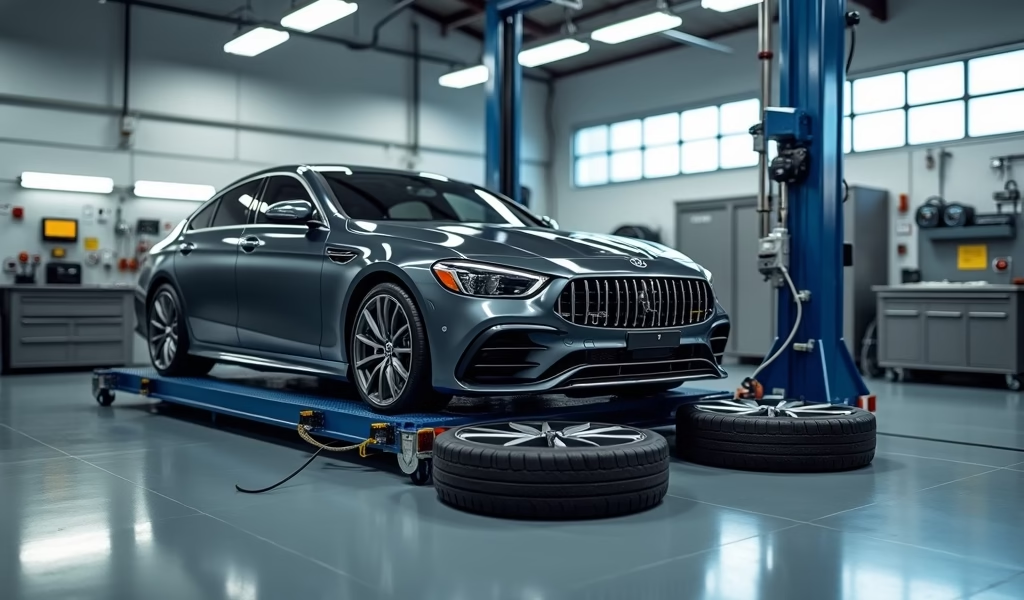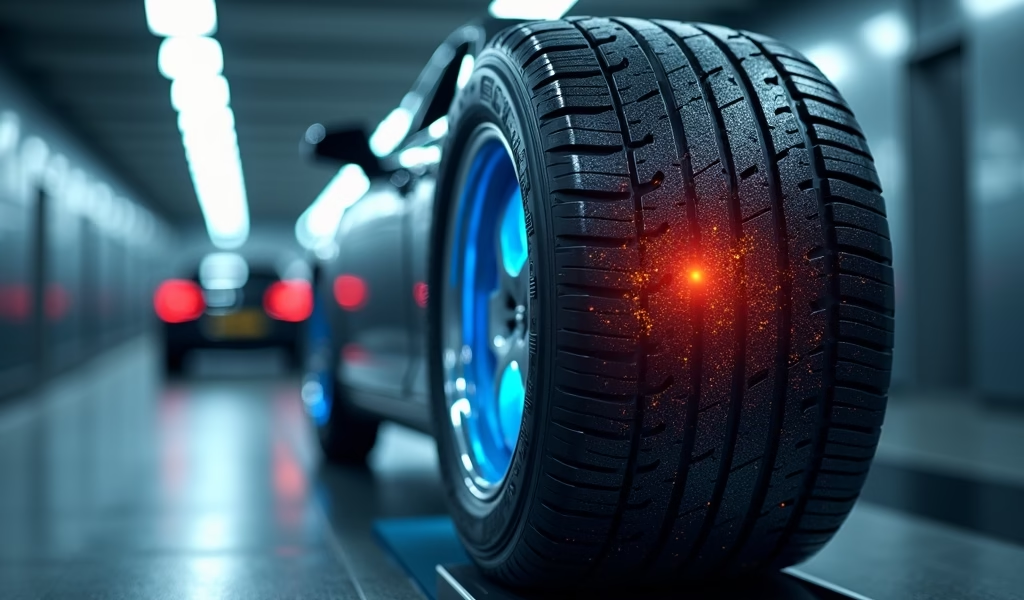Overview
This article explains five solutions to tire uniformity problems that cause vehicle vibration and handling issues: proper balancing, addressing manufacturing defects, correct mounting techniques, strategic tire rotation, and advanced tire-to-vehicle matching. Each fix helps optimize tire performance, improving driving comfort, extending tire life, enhancing safety, and reducing wear on suspension components.
Table of Contents
- Understanding Tire Uniformity
- Consequences of Poor Tire Uniformity
- Fix #1: Proper Tire Balancing
- Fix #2: Addressing Manufacturing Defects
- Fix #3: Correct Tire Mounting
- Fix #4: Tire Rotation Strategies
- Fix #5: Advanced Matching Techniques
- Conclusion
- Frequently Asked Questions
Ever felt that annoying shimmy in your steering wheel at highway speeds? Or noticed your vehicle vibrating when you least expect it? These irritating sensations often stem from a single culprit: tire non-uniformity. As a mechanic with 15 years of experience, I’ve seen countless drivers struggle with this issue without understanding its root cause.
Tire uniformity measurement is the process of evaluating how consistently a tire maintains its shape, structure, and performance as it rotates. When tires lack uniformity, they create a cascade of problems affecting your vehicle’s performance, safety, and comfort. In this guide, I’ll walk you through five practical fixes that can transform your driving experience from jarring to joyful.
Understanding Tire Uniformity
In simple terms, tire uniformity refers to how consistently round and balanced a tire is. A perfectly uniform tire would exert exactly the same forces on your vehicle no matter where it is in its rotation cycle. Unfortunately, perfect uniformity doesn’t exist in the real world – even brand new tires have slight variations.
When measuring tire uniformity, we look at several key parameters:
- Radial Force Variation (RFV): Changes in the tire’s stiffness as it rotates, causing up-and-down vibrations
- Lateral Force Variation (LFV): Side-to-side force changes during rotation, often causing steering wheel wobble
- Conicity: A tire’s tendency to pull to one side due to asymmetrical construction
- Runout: The physical deviation from a perfectly round shape
These aren’t just technical terms – they directly affect what you feel behind the wheel. Modern tire manufacturers use sophisticated machines that spin tires at high speeds against instrumented rollers to detect variations as small as fractions of a pound of force. This comprehensive testing process helps ensure the tires that reach your vehicle meet stringent uniformity standards.
Consequences of Poor Tire Uniformity
Non-uniform tires create problems that go far beyond mere discomfort. When your tires lack proper uniformity, you might experience:
- Persistent vibration at specific speed ranges
- Steering wheel shake or shimmy
- Uneven or accelerated tire wear
- Increased road noise and harshness
- Reduced handling precision and stability
- Decreased fuel efficiency due to inconsistent rolling resistance coefficient
These issues don’t just affect your driving enjoyment – they impact safety and your wallet. Premature tire replacement and potential suspension damage from prolonged vibrations can add up to significant expenses over time. The good news? Many uniformity issues can be effectively addressed with the right approach.

Fix #1: Proper Tire Balancing
Think of tire balancing as the foundation for addressing uniformity issues. While balancing alone can’t fix all uniformity problems, it’s often the first and most crucial step in the process.
Static vs. Dynamic Balancing
There are two main types of balancing to know about:
- Static balancing addresses weight imbalance in a single plane, like placing weights at the heaviest point of a tire to counteract it – think of balancing a seesaw
- Dynamic balancing considers imbalances in multiple planes, addressing complex vibrations that static balancing might miss – this is the standard for modern vehicles
For best results, I always recommend dynamic balancing on a computerized machine. These sophisticated balancers can detect not only where to place weights but also identify force variations that might indicate deeper uniformity issues.
Road Force Balancing
If you’re experiencing persistent vibrations even after conventional balancing, ask for road force balancing. This specialized process applies pressure to the tire during balancing, simulating real-world driving conditions to identify problems that standard balancing might miss.
Road force balancers can measure how the tire contact patch pressure varies as the tire rotates, often revealing uniformity issues that wouldn’t otherwise be detected. This advanced measurement allows technicians to match-mount tires to wheels in ways that minimize overall vibration.
Fix #2: Addressing Manufacturing Defects
Not every tire comes off the production line in perfect condition. Manufacturing defects represent a common source of uniformity issues, and recognizing them early can save you considerable headaches.
Common Manufacturing Issues
Watch for these telltale signs of manufacturing defects:
- Belt separation: When internal steel belts become partially detached from surrounding rubber
- Ply separation: Similar to belt separation but involving the body plies
- Bead issues: Imperfections that prevent proper seating on the wheel
- Tread splices: Inconsistencies where the ends of the tread material join
- Sidewall bulges: Localized weaknesses in the sidewall structure
If you notice any of these issues, especially within the first few thousand miles of tire life, you’re likely dealing with a manufacturing defect rather than a maintenance or alignment problem.
Warranty Considerations
Most quality tires come with warranties that cover manufacturing defects. If you notice uniformity issues within the first 10% of the tire’s tread life, document the problems immediately and contact the retailer where you purchased the tires.
Be prepared to have the tires inspected by an authorized dealer. Many major manufacturers have specific programs for handling uniformity complaints. According to National Highway Traffic Safety Administration, tire defects affecting performance or safety may qualify for warranty replacement even outside standard coverage periods.
Fix #3: Correct Tire Mounting
Even perfectly manufactured tires can develop uniformity problems if mounted incorrectly. Proper mounting ensures that tire and wheel function as a unified assembly rather than fighting against each other.
Best Practices for Tire Mounting
Follow these critical steps for optimal tire mounting:
- Clean the wheel’s bead seat area thoroughly
- Apply appropriate mounting lubricant to both tire beads
- Position the tire correctly relative to any balance marks
- Use proper mounting tools that won’t damage the tire or wheel
- Ensure the tire bead progressively seats during inflation
- Verify proper bead seating with the “rib line” check
The bead area where the tire meets the wheel must form an airtight, concentric seal. You can verify proper seating by checking that the molded rib near the tire’s lower sidewall sits at an equal distance from the wheel all the way around on both sides.
Match-Mounting
For optimal uniformity, consider match-mounting, where the tire’s high spot (often marked with a red dot) is aligned with the wheel’s low spot. This technique helps minimize the combined runout of the tire-wheel assembly, reducing vibration and promoting even wear.
The tire compound durometer rating can also affect mounting characteristics – softer compounds typically require more careful mounting to prevent bead damage and uniformity issues.

Fix #4: Tire Rotation Strategies
Strategic tire rotation can prevent minor uniformity issues from developing into major problems. By redistributing wear patterns, rotation helps maintain more consistent tire performance over time.
Rotation Patterns Based on Vehicle Type
Different vehicles require different rotation patterns:
- Front-Wheel Drive: Use a forward cross pattern where front tires move straight back, and rear tires move forward and diagonally across
- Rear-Wheel Drive: Use a rearward cross pattern (opposite of FWD pattern)
- All-Wheel Drive: X-pattern, where each tire moves diagonally to the opposite corner
- Directional Tires: Side-to-side rotation only (front left to front right, etc.)
For most vehicles, rotating tires every 5,000-7,000 miles provides the best balance between maintenance cost and tire life optimization. However, if you notice uneven wear or vibration developing, don’t wait for the scheduled rotation – address it immediately.
Strategic Positioning
If you’ve identified tires with slight uniformity issues, strategic positioning can minimize their impact:
- Place tires with the best uniformity on the front axle to reduce steering feedback
- Position tires with slight pull tendencies on opposite sides to neutralize their effects
- Move tires with minor vibration issues to non-drive axles where they typically cause less noticeable effects
Keep detailed records of each rotation, noting date, mileage, position changes, and any observations about wear patterns. This documentation helps identify recurring patterns and predict future issues before they affect your driving experience.
Fix #5: Advanced Matching Techniques
For those seeking the ultimate in smooth, vibration-free driving, advanced matching techniques represent the pinnacle of tire uniformity optimization. These approaches treat the tire, wheel, and vehicle as an integrated system.
Tire-to-Vehicle Matching
Different positions on a vehicle respond differently to uniformity issues:
- Tires with slight conicity perform better on rear axles where they have less influence on steering
- Place tires with the lowest radial force variation on the front for reduced steering wheel vibration
- Position tires with higher uniformity measurements on the non-drive axle when possible
Some performance-focused shops offer detailed harmonics testing that can identify which specific tire positions will create the least vibration on your particular vehicle.
Using Uniformity Data Strategically
Most premium tires come from the factory with uniformity measurements indicated by colored dots or marks:
- Red dots often indicate the point of maximum radial force variation
- Yellow dots typically mark the tire’s lightest point
- White dots may indicate the point of maximum radial runout
By aligning these markers properly with valve stems or wheel features, technicians can minimize the impact of unavoidable variations. The most advanced shops use equipment like Hunter Road Force Elite balancers that measure loaded runout, effectively simulating actual driving conditions.
Conclusion
Tire uniformity issues might seem like minor annoyances, but they can significantly impact your vehicle’s performance, safety, and longevity. By implementing these five key fixes – proper balancing, addressing manufacturing defects, correct mounting, strategic rotation, and advanced matching techniques – you can transform your driving experience.
The benefits extend far beyond comfort. Properly addressed uniformity issues lead to extended tire life, improved fuel efficiency, enhanced safety through better handling, and reduced stress on suspension components. While some uniformity issues can be tackled through DIY approaches, others require professional equipment and expertise.
Remember that tire uniformity is about more than just a smooth ride – it’s about maximizing the performance of one of your vehicle’s most critical safety systems. Don’t let vibrations, shimmies, or unusual wear patterns go unaddressed. With the right approach, you can enjoy smoother, safer drives and get the most value from your tire investment.
Frequently Asked Questions
What causes poor tire uniformity?
Poor tire uniformity typically stems from manufacturing defects, improper mounting, wheel damage, or uneven wear patterns. Environmental factors like temperature fluctuations and road conditions can also contribute to uniformity degradation over time.
How can I tell if my tires have uniformity issues?
Look for symptoms like steering wheel vibration at specific speeds, unusual tire wear patterns, or vehicle shimmy during acceleration. Persistent pulling to one side despite proper alignment can also indicate uniformity problems.
Will tire balancing fix all uniformity problems?
No, balancing only addresses weight distribution issues in the tire/wheel assembly. Other uniformity problems like radial force variation or conicity require additional specialized techniques beyond standard balancing.
How often should tires be checked for uniformity issues?
Have tire uniformity evaluated whenever you experience new vibrations or during regular tire rotations (every 5,000-7,000 miles). A quick inspection during routine maintenance can catch developing problems before they worsen.
Are uniformity issues covered under tire warranties?
Most major manufacturers cover significant uniformity defects under warranty, especially within the first 10% of tread life. Document any issues immediately and contact your tire retailer for warranty consideration and potential replacement.

